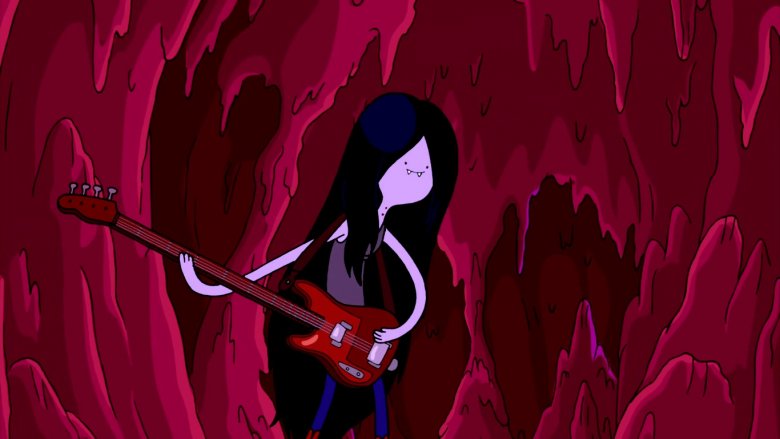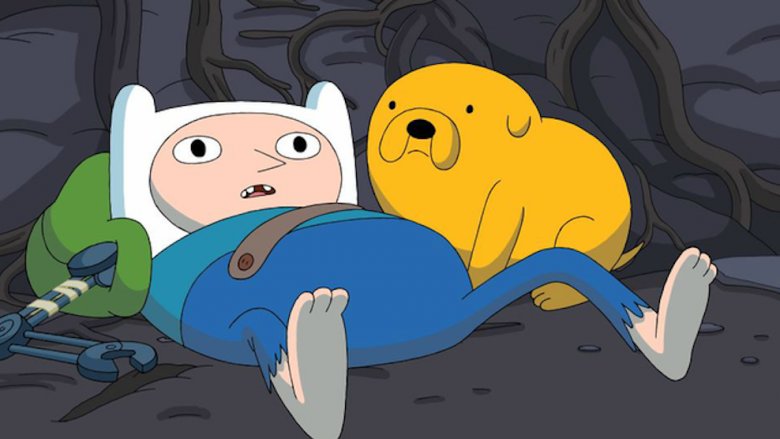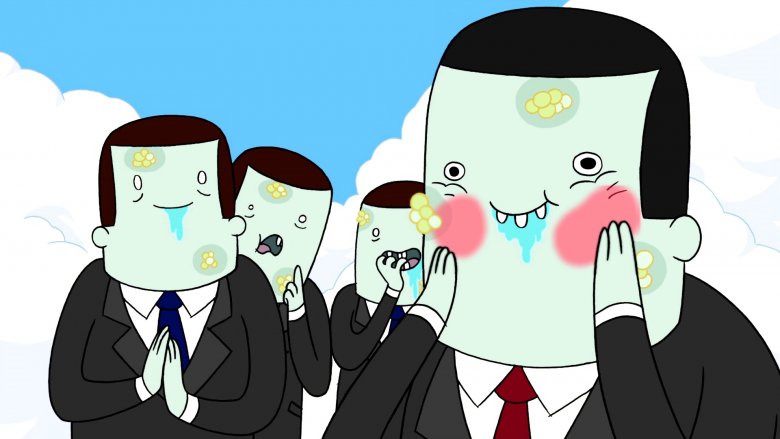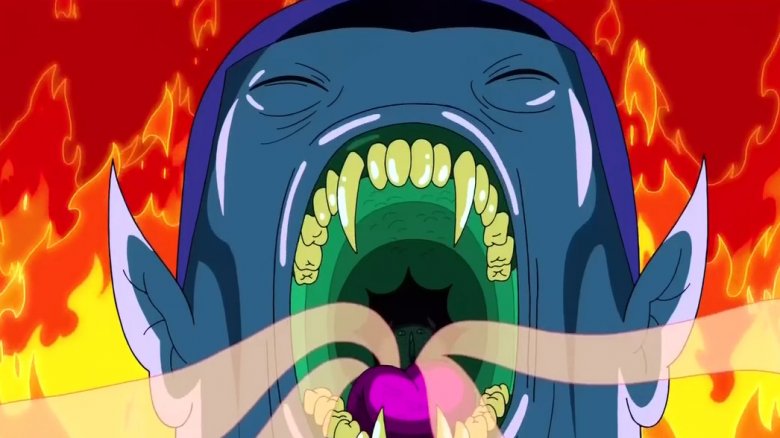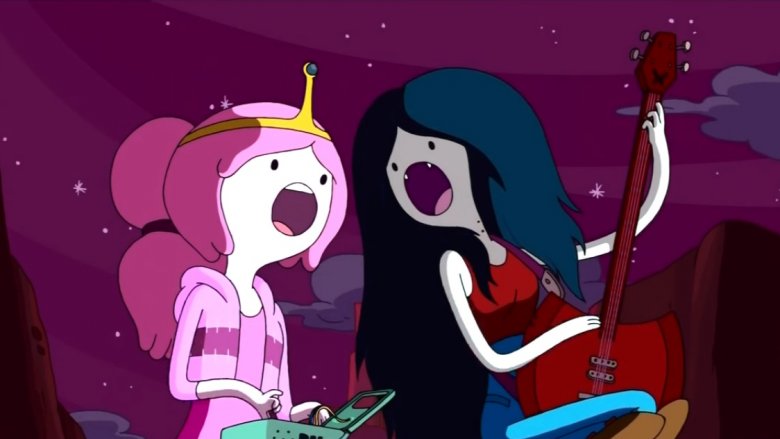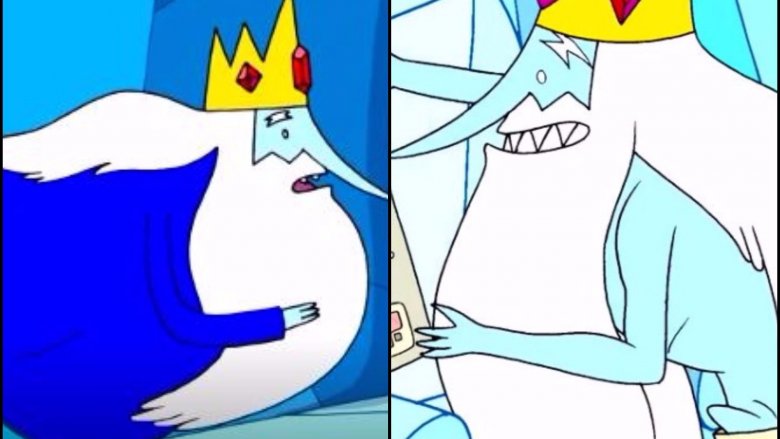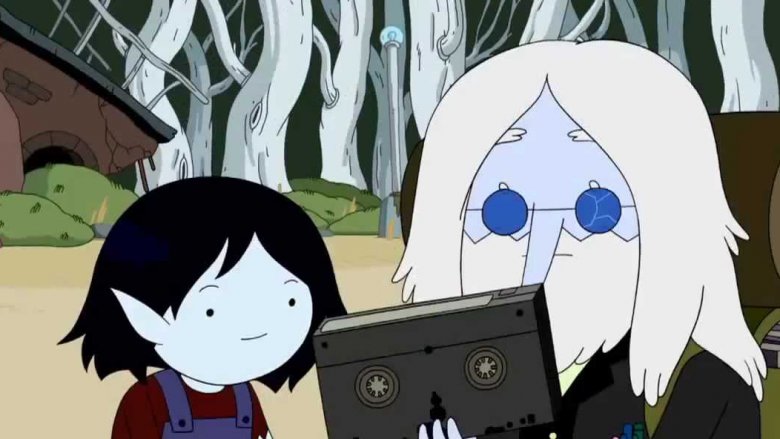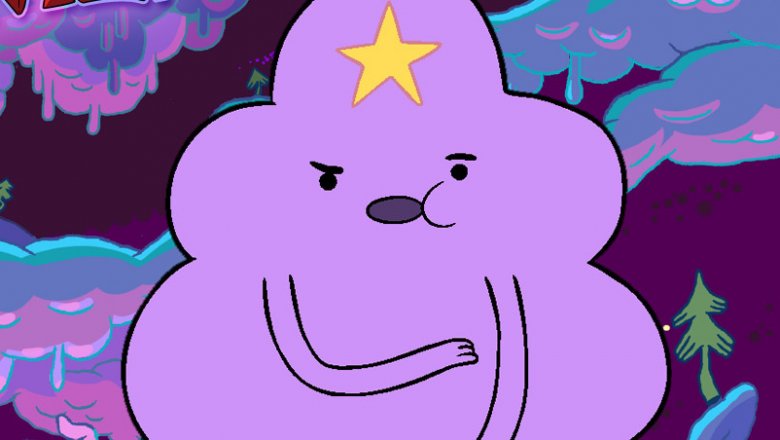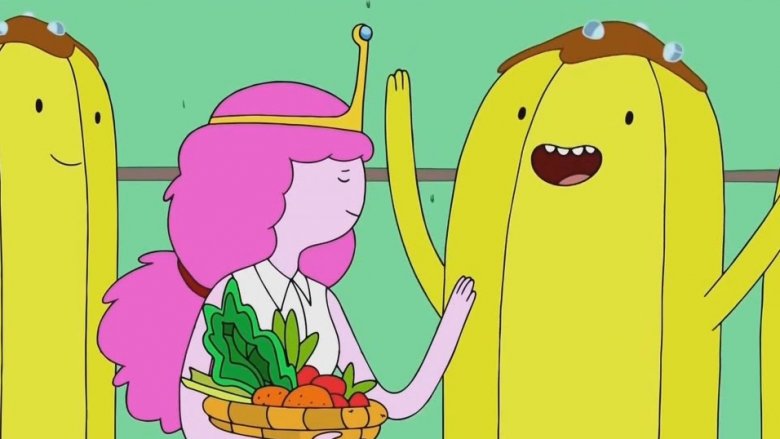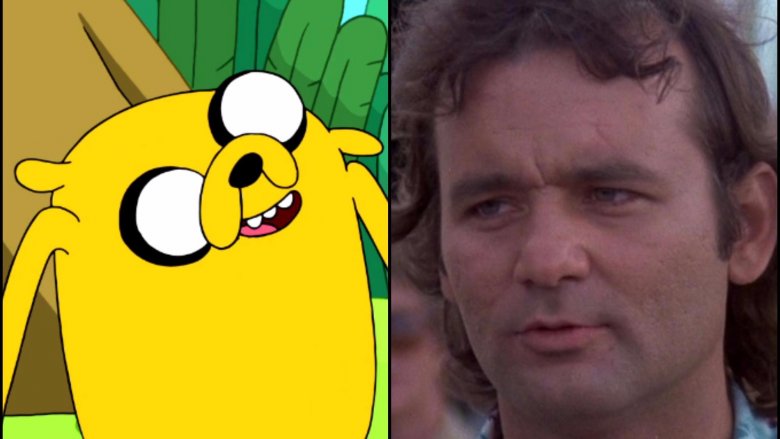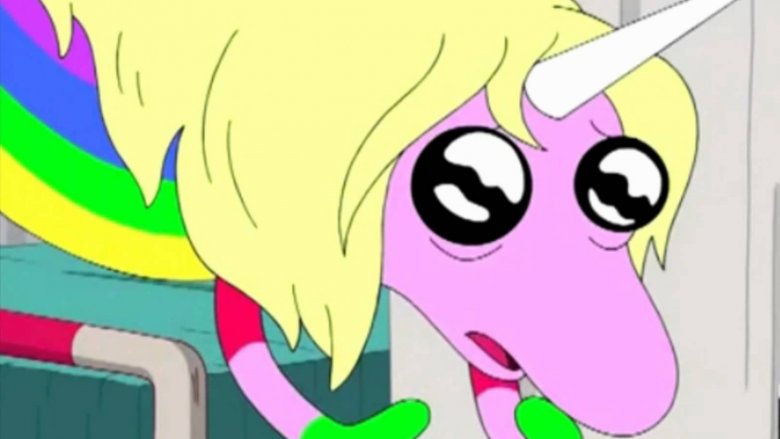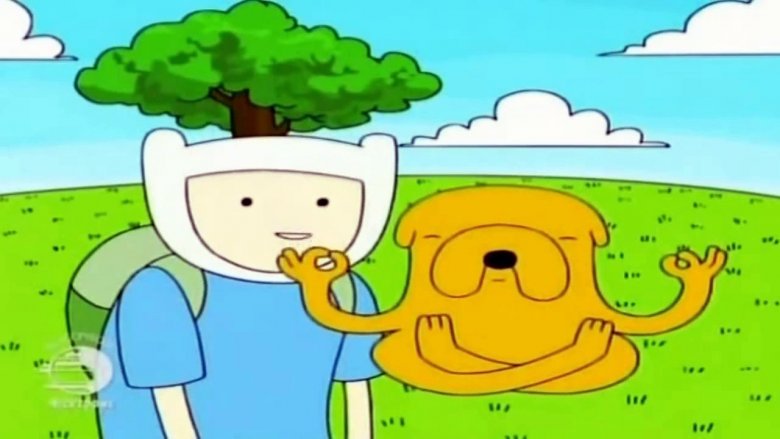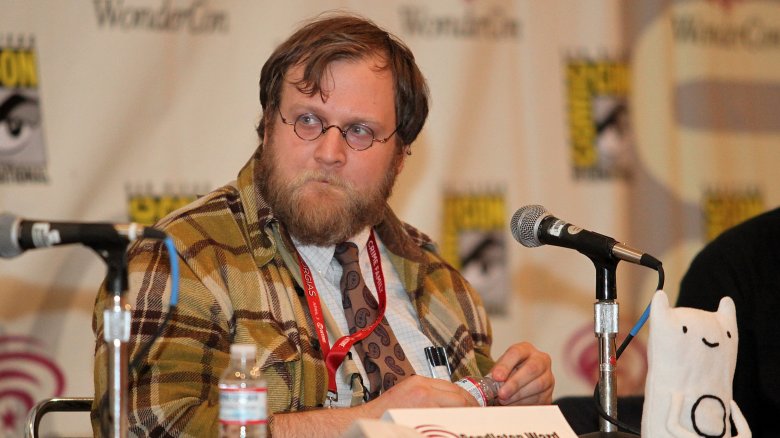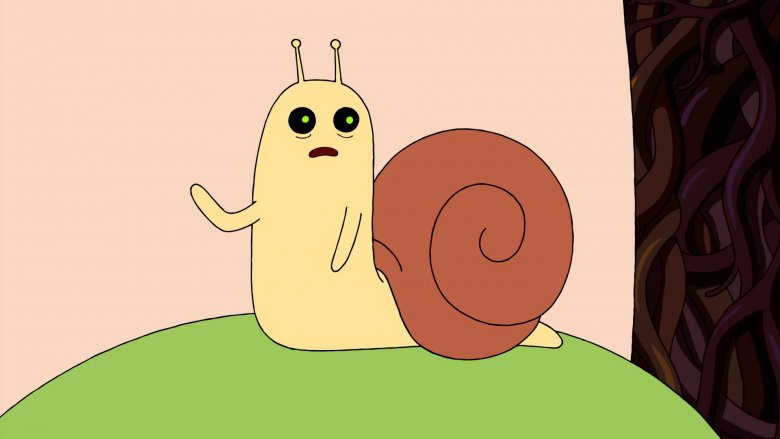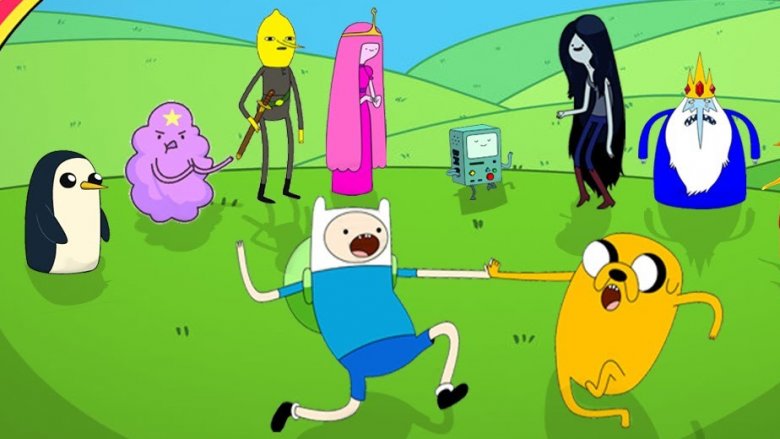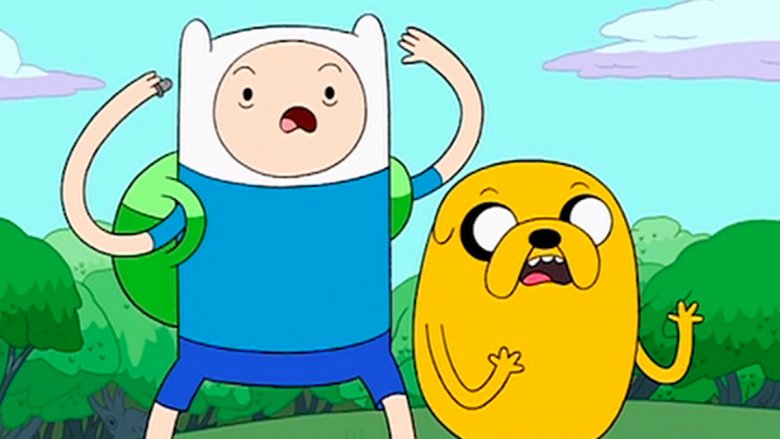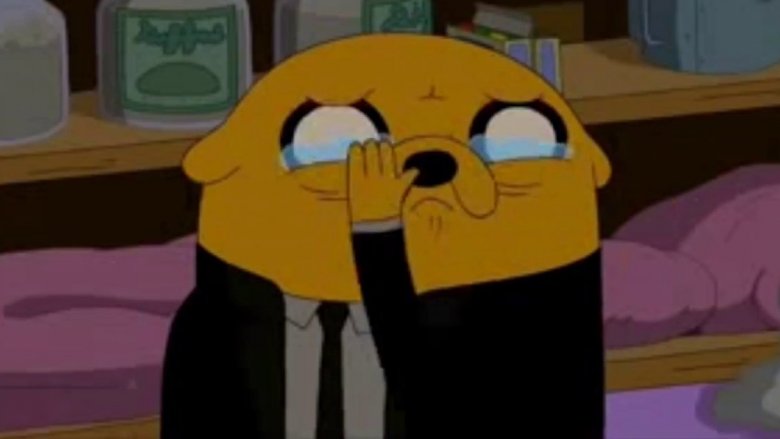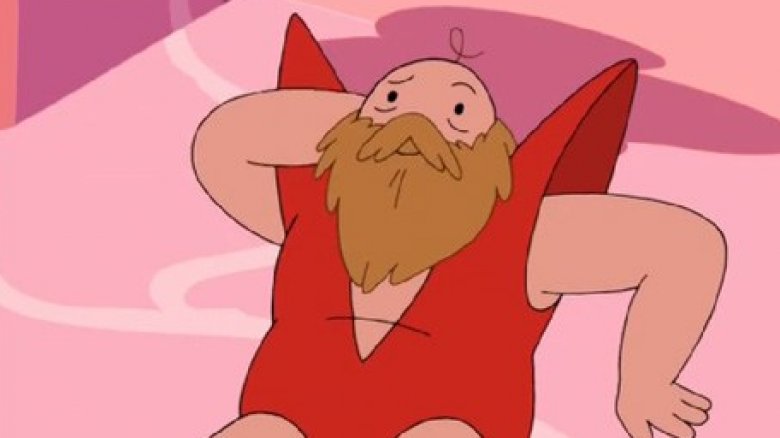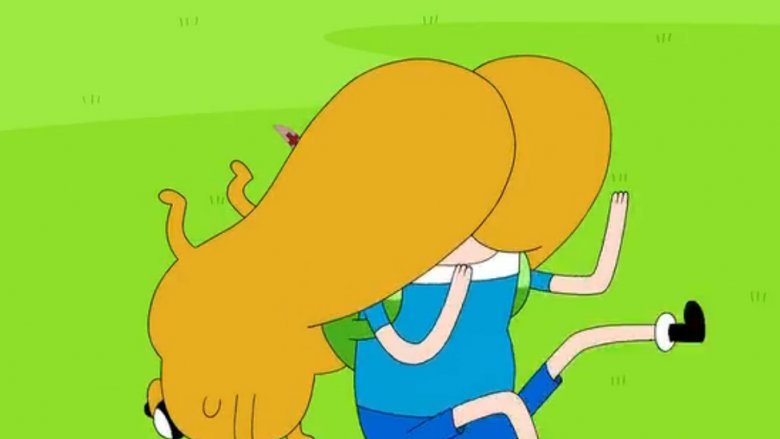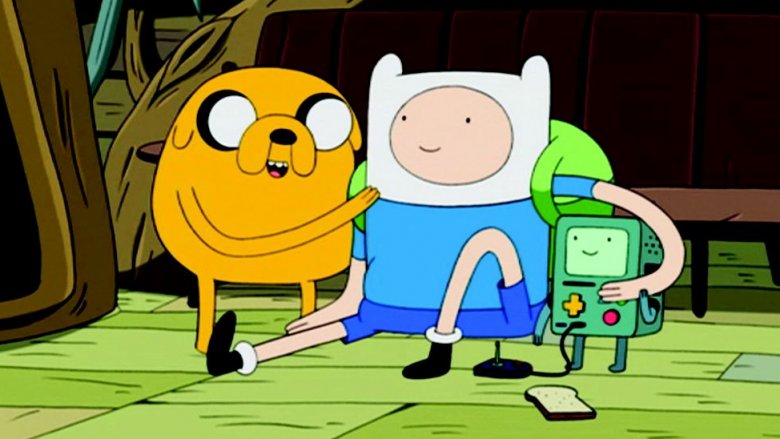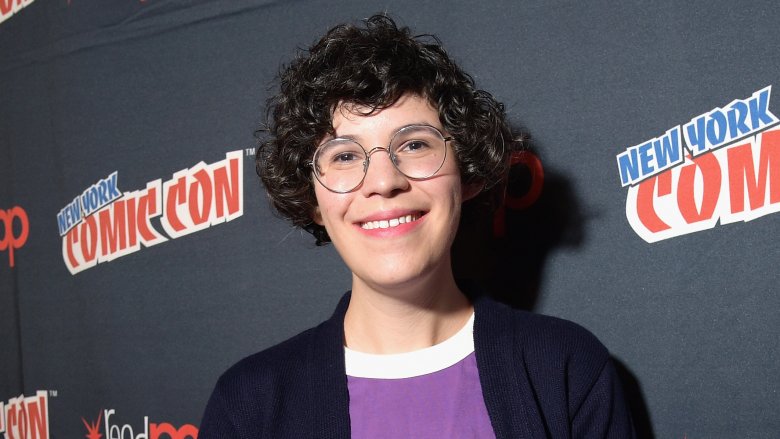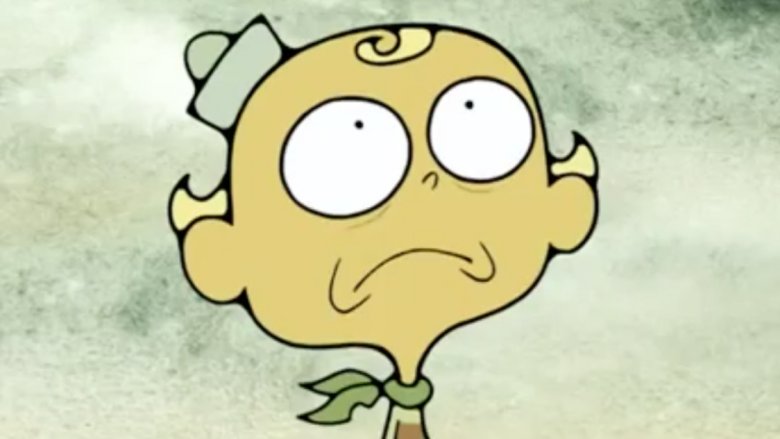The Untold Truth Of Adventure Time
Pendleton Ward's one-of-a kind Cartoon Network classic Adventure Time has now spanned 10 seasons, countless comics, and tons of merchandise. It's easy to see why fans would instantly fall in love with these quirky characters and the strange, beautiful, surreal world of Ooo. So, whether you're a lifelong fan of Finn the dog and Jake the human, or if you're just curious what the buzz is all about (especially as the series approaches its final episode), we've got the perfect guide for you.
It started with a song
It's almost impossible to discuss Adventure Time without discussing its music. At any given point, characters are likely to burst into songs that range from emotionally intense (such as Marceline's "I'm Just Your Problem") to bizarre and surreal (such as Finn and Jake's "political rap" created to rile up denizens of the Nightosphere). However, the most famous Adventure Time song would be the one that opens every single episode. The song is simple but full of whimsy and the promise of adventures and fun. It's the perfect encapsulation of the series ... which is fitting because this song is how the series truly began.
When series creator Pendleton Ward went to pitch the first Adventure Time cartoon (an animated short), he brought in some more traditional pitching equipment, such as storyboards. However, he also brought along his guitar so that he could sing the opening theme song for the executives. They liked the song well enough to order the short, and the short's popularity snowballed into an order for the series that we know and love. For that series, Ward rerecorded the song using a ukulele instead of a guitar. It was meant to be a temporary recording to quickly submit to Cartoon Network (that's why careful listeners can hear typing in the background of the song, as it was recorded in a cramped room), but Ward fell in love with it and never agreed to replace it, despite later attempts at rerecording it.
Nickelodeon passed on it
Picture it: At a mall somewhere in America, a Nickelodeon programming executive walks by a Hot Topic. He or she sees the plethora of Adventure Time merchandise on sale, from "Mathematical!" keychains to plush Jake toys to Finn-style white hats. The executive weeps for what could have been. For while Adventure Time has been a massive critical and commercial success for Cartoon Network since its debut on the channel in 2010, the show was initially rejected by the once-prime destination for kid-friendly entertainment, Nickelodeon. Actually, it gets worse. The network rejected Adventure Time twice.
Accidental apocalypse
Considering it's typically a funny cartoon with lighthearted characters, one of the oddest elements of Adventure Time is that it's explicitly a post-apocalyptic show. Over the course of many seasons, we piece together some of the events surrounding a Mushroom War that seemingly killed most of the humans, created mutations, and took a giant chunk out of the Earth. Considering all of this detail, it would certainly seem like the creators had a plan all along. But this post-apocalyptic setting came about completely by accident.
Early in the first season, the show was meant to be more of a straightforward fantasy series. This seemed clear with its emphasis on sword-wielding heroes, beautiful princesses, enchanted kingdoms, and so on. However, in one episode, the characters encounter some 21st-century businessmen that have been frozen in an iceberg. This was truly a game-changer, as it meant the world of Finn and Jake had once been very much like our own before it was irrevocably changed. Seeing that the die was now cast, the writers ran with the apocalyptic idea, crafting nuanced stories about how that time period was formative for both Marceline and the Ice King (characters who are functionally immortal). This setting adds an air of melancholy to even the most lighthearted episodes, but the setting would never have existed at all if the writers didn't think frozen businessmen would be a funny concept.
Marceline's father is voiced by her voice actor's father
Marcline morphed into a fan-favorite character after her earliest appearance. She originally served as a kind of antagonist for Finn and Jake but became their gothy, guitar-rocking older friend. Like many of the characters, she carries baggage from the past, and hers centers on daddy issues. Finn and Jake encounter her father, who turns out to be a kind of evil VIP: he is the ruler of the Nightosphere, which is Adventure Time's version of hell. To the voice actor for Marceline, he's a different kind of VIP: he is her father.
The voice actor for Marceline is Olivia Olson, and her adoptive father, Martin Olson, plays her onscreen father, Hunson Abadeer. The elder Olson is a veteran comedian, singer, and a writer for shows like Phineas and Ferb, but he seems to have taken a special liking to Adventure Time. In addition to playing as Abadeer, Martin Olson was the writer of the popular Adventure Time Encyclopedia. Later, he teamed up with Olivia Olson to write The Enchiridion & Marcy's Super Secret Scrapbook, which further fleshed out the interior life of Marceline and the impact that the departure of her father had on her.
The weird history of Bubblegum and Marceline's relationship
One of the longest-running areas of discussion surrounding Adventure Time is whether Marceline the Vampire Queen and Princess Bubblegum were ever a couple in the past. This speculation kicked into high gear after the third season episode "What Was Missing." A mysterious creature steals personal items from different characters and then hides behind a door that can only be opened by a "song from a genuine band." The characters form an ersatz band, and veteran singer Marceline starts singing a breezy song about sucking the color off of Princess Bubblegum's face. When Bubblegum objects, Marceline launches into a song that sarcastically apologized for not treating Bubblegum like a goddess, asked if Marceline was not sweet enough for her, and proclaimed that Marceline shouldn't have to prove anything to her. The catchy song made it sound a lot like the two characters were once a couple, which seemed further verified when the item stolen from Princess Bubblegum turns out to be a T-shirt from Marceline that the princess sleeps in each night.
Fans wrote reams of fanfiction and fan art about this new pairing, which they dubbed "Bubbline." And the series continued dropping hints that almost but-not-quite confirmed the characters' romantic history. Because these were only hints and the pairing was never quite confirmed, fan debate about this forbidden love became very intense indeed. However, that debate came to an end after the series finale, when Bubblegum and Marceline finally kissed.
Pendleton Ward had said he thought their relationship might never show be shown onscreen because in some of the countries that Adventure Time airs in, "It's sort of illegal." Apparently they got around that, or perhaps some of those countries just skipped the final episode of the show.
The Ice King's eating disorder
The Ice King's most familiar appearance in the show is as an overweight wizard. Other times, though, he looks downright anorexic under his robes, as with a scene in which he shows his Penguin Gunter his reflection in a mirror and says the penguin is getting fat. In that same reflection, we can pretty much count the ribs on the Ice King, which makes it likely that he is reacting in an extreme way to the kind of mocking he is now passing on to his pet penguin.
There are other scenes where he is super-thin like this and still feels the need to work out, showing a sad and obsessive worry about his weight, which continues to fluctuate up and down throughout the series. Overall, Ice King's story is one tragedy after another: he loses his fiancee to the madness of the crown and later has to abandon a young Marceline for the same reason. Now, trapped in his mind, he is unable to find romantic love, and that inability drives him to either overeat or completely starve himself, all in a quest for happiness that will likely never come.
Is the whole thing in the Ice King's mind?
A world as complex and dark as the Land of Ooo means there are a lot of fan theories, so bear with us as we discuss yet another intriguing idea that lends even more depth to the Adventure Time mythology. Viewers know that before the Mushroom War (the apocalypse that destroyed the world) the Ice King was just a guy in his forties named Simon Petrikov. While wandering the wastes and scavenging for food, he met a 7-year-old girl named Marcy (the future Marceline the Vampire Queen), and he watched over her, making sure she was safe and entertaining her with stories.
One popular fan theory holds that the entirety of Adventure Time is among those stories, which he'd be telling to young Marcy some 1,000 years ago. Or, that's all a big load, according to Tom Kenney, the sketch comedian (Mr. Show) and voice actor (he's also SpongeBob) behind Simon/the Ice King. "Ooo is a very interesting place and Pendleton Ward is a very interesting dude, and I don't like to subscribe to theories that invalidate the world that you love going to," Kenney told the Huffington Post. "So, nah, I don't buy that one. It's too cheesy."
Pendleton Ward identifies most with Lumpy Space Princess
In addition to creating and writing for the show, Pendleton Ward serves as the voice for the long-running, always-strange Lumpy Space Princess. This unconventional character is a constant outsider, having been kicked out of her parents' house in their dimension and later shunned by other princesses on Ooo. From time to time, the character lives homeless in the woods and stoops to terrorizing villagers for food when necessary. All of which makes it that much stranger that, during a New York City Comic Con panel, Ward admitted that he identifies very closely with this character, saying he was "embarrassed" at the degree to that he can relate to her.
Ward quickly turned the revelation comedic, but there's likely some pathos and depth to the idea of this creator (often characterized as quiet and shy) identifying closely with a character that's constantly ostracized, lonely, and misunderstood.
Where John DiMaggio got the Banana Guard voice
Ah, the Banana Guard, Princess Bubblegum's potassium-rich, brain-poor protectors of the Candy Kingdom. You think she'd hire some workers who were actually competent, but you take what you can get in the Land of Ooo. Something about their voices, though, seems familiar. It might be that the head guard is voiced by John DiMaggio, who also plays Jake. No, there's something else that's familiar about the way those guards sound — and it's that they sound just like Adventure Time's Lumpy Space Princess. Show creator Pendleton Ward voices the Valley-girl-from-the-woods. But in this interview with Anime Snacktime TV, DiMaggio says his take on the Banana Guard is his impression of Ward doing the Lumpy Space Princess voice.
The Bill Murray connection
Adventure Time is steeped in pop culture, which isn't surprising considering one of the characters is a walking, talking Gameboy. One of the main characters, though, has a rather unexpected influence. According to Pendleton Ward, the character of Jake the Dog was inspired by Bill Murray's character Tripper in his sleepy, late-'70s comedy Meatballs.
In that movie, Murray plays a summer camp counselor who is a mentor to young visitors, including our protagonist Rudy. Even as Murray provides advice, he also keeps things real, such as a hilarious scene where, when asked to inspire the Camp about their upcoming competition against a well-heeled rival, instead leads a chant of "it just doesn't matter!" These elements are all in play with Jake the Dog, who plays an older, mentor role with Finn the Human but is still often goofy and refuses to take anything that seriously.
The indelible contributions of Niki Yang
Adventure Time has employed some of the animation world's best voice actors, including veterans like John DiMaggio, Maria Bamford, and Dee Bradley Baker. But one of the show's true standouts only had one acting credit to her name when she joined the cast. Niki Yang brings humor, depth, and nuance to the roles of video game character BMO and Korean-speaking rainbow unicorn Lady Rainicorn. Yang didn't have a lot of voice acting experience because her main job on Adventure Time is storyboard artist. When the scripts come to her to "visualize," Lady Rainicorn's dialogue is written in English. Yang, who is fluent in Korean, personally translates it before her recording sessions.
Pen the Human?
By now, Adventure Time fans are very familiar with the voice of Jeremy Shada, the actor who brings Finn the Human to life. However, we came close to getting an entirely different voice actor for the role: Jeremy's brother, Zack Shada.
Zack voiced the character in the Adventure Time pilot (back when the character was called "Pen" instead of "Finn" as a reference to creator Pendleton Ward), but by the time the show was becoming a full series three years later, Zack's voice had changed, and he could no longer convincingly portray a young, teenage Finn. His own younger brother, Jeremy, realizing that he sounded a lot like Zack once did, auditioned and got the role. Of course, Jeremy's own voice was destined to change, so the creators made the command decision to have the character age as the series goes on.
Pendleton Ward demoted himself
Adventure Time went from quirky cult animated series to pop-culture juggernaut in just a handful of years. While many would kill for that kind of success, Pendleton Ward found out that running a hit show of his own creation wasn't everything it was cracked up to be. "Dealing with people every day wears on you," Ward told Rolling Stone in 2014. "To spend that extra energy and time you don't have, to make something that's worth making, to make it awesome, wears you out." He went on to say that because the show kept "getting bigger" and "more popular," it was "a beast of a show." During the production of the show's fifth season, he had enough. He quit. He didn't quit the show entirely, of course; he just went back to doing what he loved most about the show, which was drawing storyboards and writing episodes.
A snail is hidden in every episode
Animators and other creators are pretty notorious for sticking weird Easter eggs in their shows for obsessive fans to find. Pendleton Ward and his team did this on a very small scale, but they managed to do it obsessively: every episode of Adventure Time has a snail hidden in it, and that snail often waves to viewers. At times, the snail has taken a prominent role in the show, as when it became an unwitting vessel for the mind of The Lich, who was also able to speak through him.
Interestingly, the snail's "Easter egg" mechanic has continued into some of the show's merchandise, such as the official Adventure Time Munchkin spinoff. In that game, the snail is hidden on several cards, whereas other cards prompt players to immediately level up if they can find a snail hidden on the table in ten seconds or less.
A movie might be on the way
The end is near: Adventure Time will conclude after nine seasons in 2018. At least the show's creative team was given more than a year's notice so they can wrap things up in a way that satisfies both themselves and fans (hopefully). But do TV shows, especially popular TV shows, ever truly end? There's always a Netflix revival or big-screen movie adaptation on the horizon. The latter, a movie, is in the works for Adventure Time. Maybe ... eventually. Warner Bros. announced an Ooo-based movie in February 2015, but six months later, the show's executive producer Adam Muto walked that back a little, remarking at New York Comic Con that there's "nothing official to announce yet" and that Pendleton Ward was "working on the premise of it." Let's just hope there isn't a real-life Mushroom War first.
Cartoon Network had no idea what it had
Adventure Time is a hard show to pigeonhole. It's definitely science-fiction, taking place in a futuristic dystopia and such. But it's also fantasy, what with all the magical wizards, princesses, and talking unicorns. Sometimes it's very funny, sometimes it's serious, and sometimes it's very sad. The show even gender-swapped itself for a while with the characters of Fionna and Cake having adventures in an alternate show universe. All those rich layers just make fans love Adventure Time more, of course, but the show's complexity stymied the Cartoon Network head office. "It was a risk. People at the network were scratching their heads," an anonymous CN staffer told IndieWire. "It never really fit into a category, so Cartoon Network didn't really have a model in which to manage its ever-growing popularity."
Adventure Time producer Fred Seibert has a theory. "Cartoon Network aims for kids ages 2 to 14," and Adventure Time catered to an audience in a much larger age range. The network could have just ignored young A.T. viewers altogether and gone for the substantial grown-up audience by moving the show to its Adult Swim late-night programming block, but "arcane corporate rules" would have prevented that from happening.
They didn't mean to cry over Ooo
The final episode of a long-running series is almost always an emotional affair. Filming a finale marks the end of a long, often life-changing chapter for actors, and when their characters are hugging each other goodbye, those tears and choking sobs are likely more real than make-believe. One doesn't see an equivalent of the Golden Girls of The Golden Girls or the Friends of Friends embracing and weeping at the end of an animated series ... mainly because if the characters aren't drawn crying, they won't be crying. But behind the scenes, the voice actors may very well need a moment to regain their composure.
John DiMaggio portrayed Jake the Dog on Adventure Time for eight years. He's a veteran voice performer, but this gig will probably go down as his most popular, maybe even more so than his role as Bender on Futurama. He felt the weight of that after he recorded his final lines. "I'm going to miss how much Jake became a part of me and I became a part of Jake," DiMaggio said at San Diego Comic-Con in 2018 (via Entertainment Weekly). "The last recording, I was driving home and I just burst into tears. It shocked me. I just realized how connected I was to Jake." After that revelation, Tom Kenney — the Ice King — noted, "I'm crying right now." Aw, you guys...
The Connery connection
Even a show as "out there" and wildly original as Adventure Time has to have something that inspired it, if not a lot of disparate sources that gave writers and animators all their nutty ideas. Good artists pull from everywhere, and the artists on staff at Adventure Time took cues from some very unexpected places. In 2012, A.T. creative leaders Pendleton Ward and Rebecca Sugar told io9 that their "most unlikely source of inspiration" was the 2010 made-for-ABC Family telefilm Beauty & the Briefcase. The plot (if you've somehow forgotten): Hilary Duff plays a lovelorn freelance writer who pitches a story to Cosmopolitan about going undercover at a financial company to look for romance. "I came home one day and my roommate was watching it on Netflix," Ward said. "That led to an episode where Lumpy Space Princess wants to write a book and goes undercover."
In 2016, showrunner Adam Muto told Huffington Post about the inspirations behind the physical appearance of Martin Mertens, Finn's biological dad. Muto wanted to make Martin "as roguish and dishonorable as Finn is heroic." The character's pointy and revealing red one-piece is a direct riff on the one the rougish Sean Connery wears in the notorious 1974 sci-fi dud Zardoz, courtesy of writer Steve Wolfhard, or rather "Steve's impression of Sean Connery's costume in Zardoz without having seen the movie."
This story stinks
Adventure Time was often dark and almost always weird, but Cartoon Network generally took a hands-off approach to the show. Adventure Time's writers had the freedom to explore the Land of Ooo and its characters, but keep in mind that Cartoon Network is first and foremost a channel geared toward children, which means some content restrictions were in place. Creator Pendleton Ward told AV Club in 2012 that any changes he and his staff had to make "all comes back to a lot of poop and fart stuff." (In TV, especially kiddie TV, it always comes back to poop and fart stuff.)
Ward recalls one particular instance in which he was finalizing the audio for an episode at a post-production facility. It was crucial "for the story to work, for the jokes to work" for the episode to contain "a really long fart sound." Ward had to get on the phone and have "a really serious conversation with the network about making sure that this fart can stay in there." He and this de facto censor "went back and forth about how juicy it could be." In the end, Ward and the network representative agreed the fart wouldn't be juicy, but "really dry" and not "diarrhetic." Then Ward hung up and made the Cartoon Network-sanctioned fart sound into the microphone himself, with his mouth.
It'll be back (probably)
Whether or not a movie ever comes to fruition, Adventure Time may still be subject to the fads and whims of the television world from which it left not that long ago. The name of the game in TV right now is reboots and revivals — it seems like every halfway-popular show from decades ago is now back on screens, everything from Murphy Brown to Will & Grace to Charmed. It's even a phenomenon in the animated world — witness the rebirths of She-Ra, ThunderCats, and possibly King of the Hill.
All this is to say that new episodes of Adventure Time are probably an inevitability. "I don't even think it's an option," final Adventure Time showrunner Adam Muto told Dot and Line. "I think that will just happen, and it's when it will happen. That's just how franchises are now. Will it happen now or 10 years from now? I don't know."
You get a show! You get a show! You get a show!
Landing a job on the staff at a long-running Cartoon Network series is an achievement unto itself. It's even more meaningful for writers, animators, and voice actors when that show is something like Adventure Time — immensely popular, explosively creative, and on the air for years and years to guarantee a paycheck. Pendleton Ward and other higher-ups on the show clearly had an eye for talent because the show's credits also serve as a list of the most important names in 21st-century animation. Many cartoon visionaries got their starts (or big breaks) making the Land of Ooo come to life for Cartoon Network, and Cartoon Network kept them and their talents in the corporate family.
Rebecca Sugar wrote 22 early episodes of Adventure Time before moving on to her own series, Steven Universe. Patrick McHale penned nearly 100 episodes over the show's entire run, taking some time in the middle to develop his fantasy miniseries Over the Garden Wall. Skyler Page wrote for Adventure Time before he created Clarence. J.G. Quintel and Pete Browngardt both served on the staff before leaving to focus on their own boundary-pushing series, Regular Show and Uncle Grandpa, respectively. Voice actor Justin Roiland wrote for television both before and after he played the Earl of Lemongrab on Adventure Time — he's the co-creator of Rick and Morty.
A Flap over a fan theory
Almost all TV shows are subject to "fan theories." These ideas suggest something sinister below the surface of a show, that there are dark motivations for characters, or that things are not as they seem ... and that numerous clues lead viewers to this hidden truth. (Never mind that a show's staff of professional writers would and could probably just, you know, explicitly write what they want to happen instead of leaving subtle "clues" that never pay off.) Adventure Time boasts more than its fair share of fan theories, probably because it takes place in such a bizarre and complex setting. Fans probably want nonsensical things to make sense, leading to the notion, for example, that Adventure Time does not depict events as they happen to Jake the Dog and Finn the Human. Instead, according to this fan theory, a father and son are playing a Dungeons & Dragons-like role-playing game. (The dad is Jake, and the kid is Finn.)
Another fan theory tries to link the work of creator Pendleton Ward into one cohesive animated "universe," the way all those Marvel movies will overlap each other from now until the heat death of the universe. Ward served as a writer and storyboard artist on Cartoon Network's silly pirate cartoon The Marvelous Misadventures of Flapjack, and some fans think the vaguely apocalyptic setting of the latter implies that it was also affected by the Great Mushroom War.
